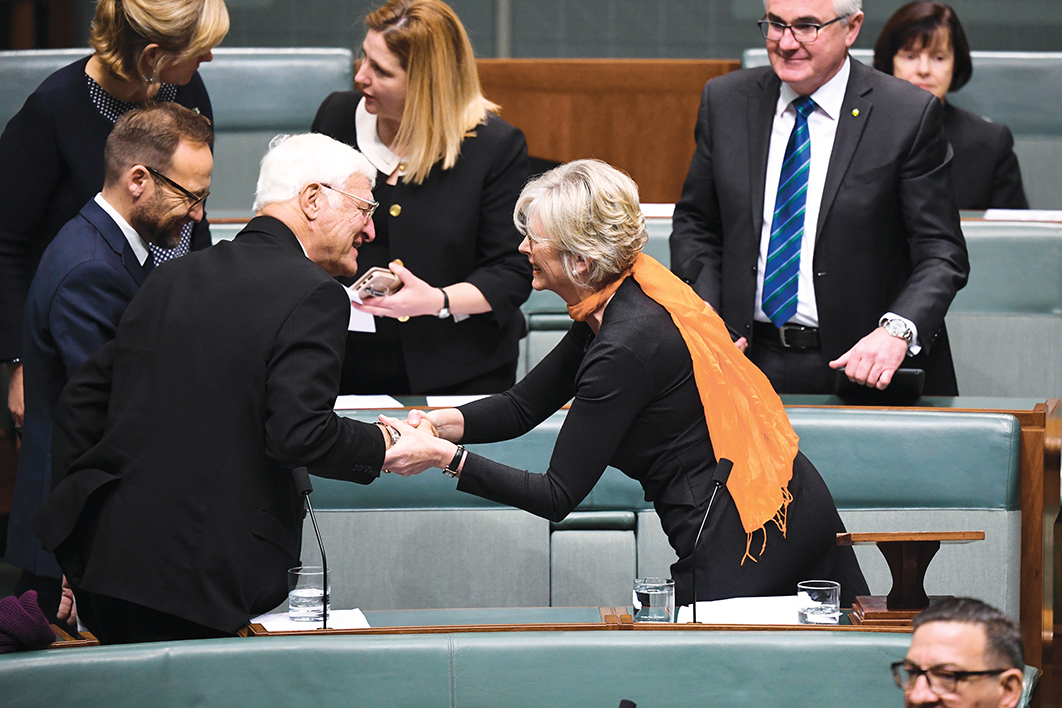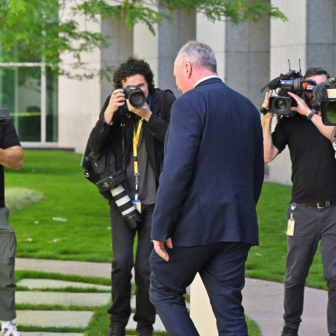It’s become a truism that contemporary Australian governments are gun-shy when it comes to reform. Problems are left to fester even when workable remedies are at hand.
The most glaring example is the lack of systematic action on climate change. Australia drags the chain on emissions reduction and continues to punt on energy-intensive exports with a dwindling customer base. A price on carbon wouldn’t have solved all our climate challenges, but it would have left us better placed than we are now.
The failure to rein in house prices is another case in point. The tax system has helped turn housing into a speculative asset, pushing funds into property rather than productive sectors of the economy, driving household debt to spectacular levels, and ramping up inequality. Again, reforming the tax treatment of residential property would hardly solve all our housing woes, but it would ameliorate some of the real estate boom’s worst effects.
In a new essay in Monash University Publishing’s “In the National Interest” series, Wayne Errington and Peter van Onselen argue that carbon pricing and property tax reform have become “pariah policies.” Despite evidence that they would have a net positive impact on Australian society, these measures have become untouchable. Events bolster their case: as we gear up for a federal election, Labor has walked away from its modest reforms to negative gearing and capital gains, and the phrases “carbon price” and “emissions trading” are banned from its political lexicon.
But, Errington and van Onselen argue, weak opposition means poor government: “The progressive side of the two-party divide is too inept to apply pressure to the conservative side, meaning conservatives stay in government without lifting their game.”
The title of their short book is Who Dares Loses. If this bleak declaration is true, then ambitious policy proposals are a recipe for electoral defeat, which appears to be the conclusion Labor has drawn from its loss in 2019. The flip side is that winners aren’t reformers. Having achieved office, governments avoid risking political capital to change society for the better.
Errington and van Onselen set out to “selectively challenge the conventional wisdom” by arguing the case for several “pariah policies,” including a universal basic income, the reintroduction of estate duties, a tax on the family home, a price on carbon, a levy on sugar, and the commercialisation of the ABC. Some of their arguments are convincing, others less so.
The case for a levy on sugar is strong. It would induce manufacturers to produce healthier food and encourage consumers to eat it, reducing the burden of diseases like diabetes and raising extra health dollars to boot. The idea that education campaigns and better labelling can drive this much-needed behavioural change was debunked long ago.
By contrast, the case for putting ads on the ABC is thin. Bizarrely, the authors propose this as a way of countering the decline of quality journalism in Australia. Their argument runs as follows: having lost valuable revenue streams like classified ads, commercial media have cut their newsrooms to the bone; as a result, subsidies for investigative reporting and quality debate must now “reach beyond the current public broadcasters.” So far so good — the case for funding more public interest journalism is strong. But their conclusion — that the ABC, like SBS, “will have to generate more of its own revenue” — is a non sequitur.
Are budget constraints so great that we can only increase funding in one area by reducing it in another? Believing that would be inconsistent with Errington and van Onselen’s support for a universal basic income, at an estimated $125 billion annual cost they claim “isn’t quite as eye-watering” as it may have seemed before JobKeeper.
In order to get more of the public interest journalism and investigative reporting that the ABC still does well, they want to make the ABC more like the commercial media. With the ABC competing for ads, they say, the other networks “would have a market incentive to lift their standard of news coverage, in a bid to steal ABC viewers and their lucrative advertisers.”
The reverse scenario is far more likely — the ABC would move downmarket as it sought to peel advertising dollars away from its (more) commercial rivals. And if it succeeded, the government would quickly cut public funding accordingly.
The “pariah policies” in Who Dares Loses overlap significantly with the reforms identified by the former chief executive of Grattan Institute, John Daley, in his recent report, Gridlock. Daley identifies carbon pricing, the tax treatment of housing, and sugar taxes as areas where government action has stalled. (He doesn’t mention commercialising the ABC.) Other initiatives consigned to the too-hard basket include congestion charging on roads, raising the pension age, introducing an effective mining resource rent tax, broadening (or increasing) the GST and lifting unemployment benefits.
Gridlock sets out to answer three questions. To the first — are twenty-first-century governments more reform-averse than their predecessors? — Daley’s answer is an emphatic yes. The 1980s and 1990s under Bob Hawke, Paul Keating and, initially at least, John Howard were “golden years” for reform. We might argue about the relative merits of measures like floating the dollar, cutting tariffs, deregulating the banks, introducing compulsory superannuation, imposing the GST, and privatising Telstra, Qantas and the Commonwealth Bank, but it is hard to dispute Daley’s contention that recent governments have been far less ambitious.
Daley’s second, more difficult, question is why are contemporary governments so timid? He identifies three obstacles that seem to be stopping governments from tackling major reforms: the lack of popular support for particular changes; the power of the “shibboleths” that mark out loyalties within parties or factions; and the opposition of powerful interest groups. The size of the required budget investment can also be a barrier, but Daley dismisses as relatively insignificant two of the most oft-cited roadblocks — the Senate and the messy division of responsibilities between the Canberra and the states.
But these obstacles aren’t new. The GST was deeply unpopular, but Howard risked electoral defeat to go ahead anyway. Privatising the Commonwealth Bank contradicted Labor shibboleths, but Hawke and Keating pressed on regardless. Vested interests vigorously opposed native title legislation, but it was still steered through parliament.
What’s different today? The glib response is that we’ve stopped electing politicians willing to push through obstacles in the belief that the change is worth the fight. As we contemplate an unedifying electoral contest between “ScoMo” and “Albo,” it’s easy to believe that current leaders don’t measure up to leaders past. That might be an emotionally satisfying answer, but it leaves us hoping forlornly that someone better will eventually turn up.
Deeper answers lie in structural economic and social changes. The echo chamber of social media has driven polarisation and division. The twenty-four-hour news cycle and the professionalisation of politics mean policies are more likely to be shaped by polling and focus groups than by evidence. The shifting and shrinking bases of the major political parties have reinforced polarisation.
Meanwhile, the hollowing out of the public service, the rising power of political staffers and the outsourcing of advice to corporate consultancies have weakened governments’ capacity to generate and implement good ideas. And the “revolving door” that turns a ministerial adviser into a “government relations” professional has picked up pace, as has the “golden escalator” from ministerial portfolio to corporate board or strategic advisory role.
Daley’s third question is obvious: what is to be done? If we want more ambitious, reform-minded leaders, we need to change the system that supports the current epidemic of policy timidity. “Institutional changes to ministerial adviser roles, to processes for appointing and dismissing senior public servants, to ministerial influence over government contracts and grants, and to controls over political donations, campaign finance, lobbying, and post-politics careers would all help to break the gridlock in policy reform,” he writes.
Errington and van Onselen recommend similar changes, and throw in a shift to proportional representation. If New Zealand can change its electoral system, why can’t we? The catch, as always, is that the people we need to fix these problems are a big part of the problem. As Daley says, the institutional changes he proposes “are themselves an example of blocked policy reform.” If our political caste can’t manage to abolish franking credits, let alone create a federal corruption commission, then the chances of substantial systemic reform appear slim.
Daley puts his hope in more independent MPs getting elected to parliament and using the balance of power to force systemic change. It’s hardly a quick fix, but it chimes with the fact that the reform highlights of the past two decades — including the (shortlived) carbon pricing mechanism, the NDIS, the Gonski school funding scheme, and plain-paper cigarettes packaging — mostly came when Julia Gillard was leading a government reliant on crossbench MPs.
Daley’s conclusion suggests the answer lies in getting back to the basics of political organisation at the local level: engaging citizens, listening to their concerns, and involving them in developing campaigns and policies. This is the nuts-and-bolts work that helped the campaign for marriage equality succeed. It is the kind of community organising that elected independent Cathy McGowan in the formerly safe Liberal seat of Indi in 2013, and enabled Helen Haines to succeed her in 2019.
In other words, we need to build democracy from the bottom up, not suffer it from the top down. Electing more independents to parliament seems like a good place to start. •




